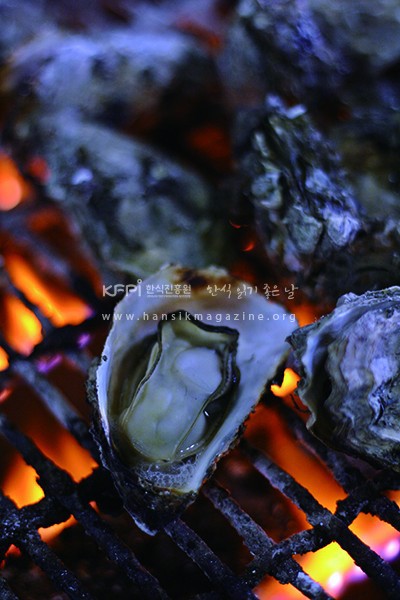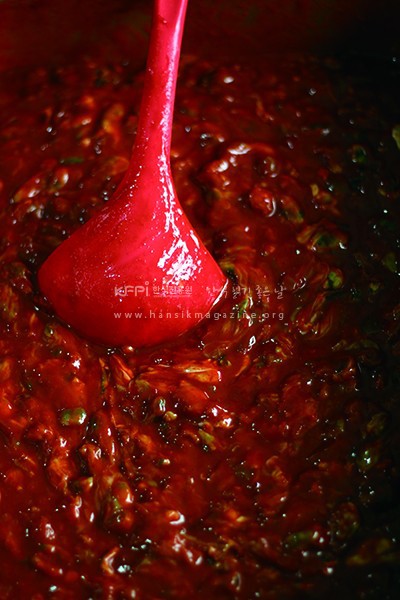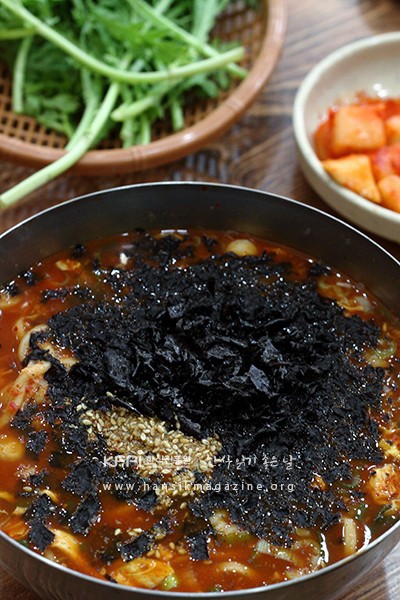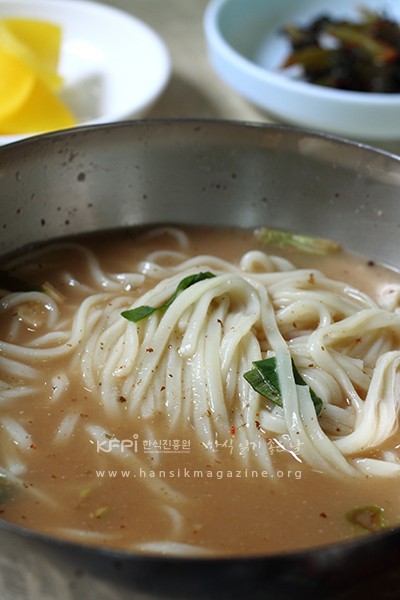한식 읽기 좋은 날
Vol 25. Jukkumi - Chungcheong
Listen to the experts
Chungcheong is the land of old civilization
Writing. photo – Park Jeongbae, Food columnist
Hansik glossary
Eoriguljeot - spicy salted oysters
Muk- jelly
Saeujeot - salted shrimp
Kkotge - Blue crab
Gejang - soy sauce marinated crab
Ureokjeotguk - salted rockfish soup
Kalguksu - noodle soup
Eojuk - fish porridge
Chungcheong is the land of old civilization. It is also the land of rice where the rice seeds of Cheongju Soro-ri were excavated for the first time in humankind’s history 15,000 years ago. As the 13-province system came into effect in 1896, Chungcheong-do was divided into Chungcheongnam-do and Chuncheongbuk-do. Chungcheongbuk-do is located in the center of Korean peninsula has no sea. Chungcheongnam-do has the curvy west coast. Food culture of harmony where crops produced by paddy farming or field farming and fishery products are appropriately mingled is blossoming.
In the inland mountainous area in the middle of Chungbuk has Many
wild vegetables & mushrooms so that there are many porridges, Noodles,
hand-pulled dough soup(“Sujebi”), pudding, With pumpkin being also popular.
Rice cakes are also prepared often.
In the west coast, soup is made with oysters or
clam meat to boil sliced rice cake soup or noodles soup,
and bean paste being incorporated frequently.
As the feature of Chungcheong-do foods,
not much seasoning is put in to save the natural tastes for savoriness and simplicity.
From ‘Traditional foods of Korea'
Chungcheong-do foods featured in 1920’s magazines
In the boast of 8 provinces in 1920’s magazine of Byeolgeongon on the eight-province representatives, there appear the foods of Chungcheong-do. Crops of Nonsan Ganggyeong do not fall behind at any yards of any province. Salted oysters with hot pepper of Seosan is the representative specialty of the entire Chosun.
/ July 1, 1925'
In the article on ‘Reputation of women’s housekeeping of 8 provinces’ published in Byeolgeongon Nos. 16 & 17 (December 1, 1928), the women at Hwangyun, Yeongdong eat so much soft persimmon as to have fat cheeks, while the women at Cheongsan, Boeun have so much jujube as to have sharp-tipped mouths, the women at Chungju, Jecheon have yellow nose tips due to yellow tobacco, the women at Yesan eat so much rice as to have a fat stomach, the women at Onyang take so much bath in the hot spring as to have soft skin, the women at Seosan eat so much salted oysters with hot pepper as to have red lips, the women at Cheonan take so much walnut to have pockmarks, & the women at Seonghwan eat so much (Gaegosagwa (name of Korean melon) as to have black skin as a feature
/ December 1, 1928
Also, in the article of Byeolgeongon dated December 1, 1929 praises for buckwheat Muk(jelly) of Chungcheong-do are overflowing. ‘When you visit Chungcheong-do, there are Muk houses in every alley like stand-up bars or ox-bone soup restaurant in Seoul. When you sit down, they bring a dishful muk, which is deceiving as you may wonder on the first sight if it is a clear noodle soup. More than anything else, it is because the muk is as thin as the noodle. In general, it is ingested by mixing with clear meat soup, where the taste of unique only for the Chungcheong-do muk with addition of gentle seasoning taste as well as meat taste is so fascinating that you’d be unaware of what is happening around you while focusing on eating. Having two or so servings when you are hungry in the dead of winter night will be quite something. The price is exactly 5 jeon. The 3 beats of hunger, savor and quaint beauty are really in the perfect match'. Thus, the food of 1920 has stayed alive up to now.
Oyster culture and Eoriguljeot
On the seashore of Chungcheongnam-do, oyster culture has been developed. If someone is asked to name the most famous food among numerous candidates of Chungcheong-do, many people point to the eoriguljeot(spicy salted oysters).
There was saying that 'If biutgui(grailled salted herring), eoriguljeot and jokpyeon(cow's foot jelly) were served on the dinner table in winter, the table was most luxurious' and there has been saying until 1980’s that if someone did not have Seosan’s eoriguljeot served on the dinner table, he was not a rich person. The word of Eorigul was generated from the combination of ‘Being young’ due to the small shape of oyster and ‘Being burning’ due to the spiciness. The place where oysters grow well is a place where fresh water is mixed with sea water. Seosan Ganwol Island has the sea into which the fresh water from Haemi mountain and Gaya mountain flows into. Oysters produced at Ganwol Island come out of the water for 4~7 hours upon ebb time. The blackish oysters of this place that grow up to only 2~3cm in 3 years are referred to as ‘Ganggul’ by the people. The fresh and taut oysters produced in winter are washed with clean sea water, diluted to 7% salt and stored in a fermentation chamber at about 15~20°C for half a month. Thus-fermented oysters are referred to as ‘Baekgul(white oyster)’. When this is sold, mixing of this with red pepper powder and other seasonings will produce eoriguljeot.
Before the reclaimed land came into being here in 1980’s, the natural oysters were called ‘Tohwa“ and the farmed oysters ’Seokhwa’ by the Ganwol Island people. The way of processing Ganwol Island oysters before creation of the reclaimed land was different from the present method. 'After washing the oysters with sea water, salt them with bay salt, and have the temperature reach 20°C to leave them immersed for about 10 days. When it is salted for slightly salty taste, water is removed by screening through a bamboo basket for mixing with finely-ground red pepper, water cooled after being boiled a day ahead is poured, and then the oysters are put in a pottery to be stored for 3 months. In a day, about 50 cans using 1–litter cans are produced all of which are sent to Seoul to be sold at a price higher than any other guljeot(salted oysters) (Discovery of Korea for Chungcheongnam-do') Although the old way does not prevail any more, the Ganwol Island people still formed a union to jointly produce and sell small, yet solid oysters in the old way, keeping the eoriguljeot.
At Seosan, people enjoyed having gulnaengguk(chilled oyster soup) in winter.
‘When soup of dongchimi(radish water kimchi) is pured after raw oysters are seasoned with green onion, garlic, thin soup, and it is seasoned with vinegar and red pepper powder to suit people’s taste, producing a refreshing cold soup. As you are said to get rid of cold when you caught cold but eat it with sticky rice, it is especially prepared for ingestion. During ordinary meals, having this soup together helps your digestion and provides a delicacy when you eat the rice with soy sauce.’ (Korea folklore survey report, On foods), At Cheonbuk of Gwangcheon, the gulgui(grilled oyster) culture created in early 90’s is popular. However, speaking of Gwangcheon cannot skip the saeujeot(salted shrimp) culture that has been famous since Chosun era. At the center of Gwangcheon-eup, there is an underground tunnel resembling a jar that is called jar rock or “Dokmae“, the saeujeot is fermented and stored here. Since the temperature of 15 to 17°C is always maintained in the underground tunnel, the taste of saeujeot is subtle and deep, making it famous’

West sea Cheonbuk oyster that is Collected from a place with a large tidal range of West Sea and has gooey taste

Eoriguljeot from Ganwol Island of West Sea
Kkotge and kkotgejang, ureokjeotguk
West coast of Chungcheong is the main producer of kkotge(blue crab). Originally, the gejang(soy sauce marinated crab) used to be the marinated hairy crab of fresh water. However, since the hairy crab have much clonorchis sinensis, a large-amount harvesting of kkotge in 1960’s made Seosan kkotge and kkotgejang became a pronoun for the gejang.
At Taean, Seosan, people enjoy ‘ureokjeotguk(salted rockfish soup). Thick flesh is eaten as steamed fish, while it is said to have been originated from the head and bones along with the bean curd served on and taken from the ancestral rite table that was boiled hard and then salted with the saeujeot for ingestion. In these days, clam, etc. may be put in the ureokjeotguk.
Kalguksu of Daejeon
Daejeon is rich in folksy foods, among which there is kalguksu(noodle soup) dish. ‘Daeseon kalguksu’ known as the oldest house of kalguksu in Daejeon since its opening in 1958, while ‘Sindo kalguksu’ in front of Daejeon railroad station was opened in 1961. Daeseon kalguksu and Sindo kalguksu are close to the south coast kalguksu based on anchovy broth. As the kalguksu of ‘Gongjubunsik’ having opened in 1975 became popular amid fervent love of Daejeon people, the kalguksu houses are settled one by one along the Sudosan-ro at Daeheung-dong in Daejeon from early 1980’s, the kalguksu alley was formed naturally. The distinct features of kalguksu restaurant of Daejeon that came into being after ‘Gongjubunsik’ include noodles filling up a large bowl, red-colored broth producing the spicy taste and shape. The red broth is added to the thick and savory taste based on the anchovy broth, spicy red pepper powder, black pepper, sesame and seaweed powder filling its top, green onion and crown daisy that cannot be omitted at the kalguksu restaurants in Daejeon, etc. to produce the model for the spicy hot Daejeon kalguksu commonly named as “Eolkal”.

Model for spicy Daejeon kalguksu commonly named ‘Eolkal’ with addition of crown daisy Kalguksu of Gongju flour-based food

Kalguksu of Sindo restaurant close to south coast kalguksu based on anchovy broth
Specialties and representative foods of Chungcheong-do
As the oldest rice producer in Korean peninsula ought to be, eojuk(fish porridge) culture has been developed in the Chungcheong-do inland. Geumsan is particularly famous for the eojuk. Baekma river basin in Yedang plain of Chungcheongnam-do is suited to farming, being rich in not only rice but also other grains. While porridges, noodles, hand-pulled dough soup, mixed-grain porridge, etc. made of various grains have been developed, frequent use of old squash is characteristic. Mr. Han Bokjin expressed his regrets in the book called ‘Foods of 8 provinces’ by saying that the spotted cantaloupes of Seonghwan and watershield plants of Jecheon could not be found while pear and Korean melon of Seonghwan, walnut of Cheonan, carp and watershield plant of Jecheon Euirimji, eoriguljeot of Ganwol Island, saeujeot of Gwangcheon were considered as the specialties of Chungcheong-do.
In addition, we have the following items as the representative foods of Chuncheong-do:
Cheonggukjangjjigae(Rich soybean paste stew) with bean curd or cabbage kimchi put in and boiled in winter, hobakjijjigae(old squash kimchi stew) with used water from washing rice poured into the cooked old squash kimchi before boiling, hobakbeombeok(mixed-grain porridge with pumkin) with sweet potato, kidney bean, etc. put in old squash for cooking to full softening. nokdujuk(mung bean porridge) cooked with rice put in the boiled, crushed and screened mung beans, cheongpomuk(mung bean jelly) with old starch dissolved in water for preparation of porridge followed by pouring in a bowl and subsequent hardening, yeolmujjanji(young summer radish preserved with salt) as the kimchi where young summer radish is pickled, mixed with green pepper, red pepper, and small green onion, put the mixture in a jar with sufficient salted wheat paste poured in as the soup before fermentation, and oiji(pickled cucumber) prepared by the method where native-kind Chosun cucumber is put neatly in a jar and pressed with a stone to prevent floating up followed by pouring of concentrated salt water.
Alongside, we have:
Soemeoritteok similar to the boiled and sliced cow head, steamed like steamed rice cake made of sedimentary rice where sticky rice and non-glutinous rice, granulated and boiled black beans & red beans, jujube with seed removed, peeled chestnut, and dried persimmon are mixed altogether and steamed in an earthenware steamer, Patjuk(red bean porridge) boiled with the small dumplings made by kneading with hot water of sticky rice powder, Naegguk(chilled oyster soup) with radish water kimchi soup poured after seasoning with green onion, garlic & soy sauce followed by marination of vinegar, hot pepper powder, Aukguk(curled Mallow Soup) of further boiling with addition of red pepper paste & bean past after boiling with dried Kuruma shrimp or clam put in, Susamjeonggwa(briased Ginseng in Sweet Sauce) prepared with sugar and water added after slight blanching of the whole ginseng of a small size or minced ginseng of a large size in boiling water.
Chungcheong-do foods put an emphasis on the ingredients representing simple and comfortable dishes.
Chungcheong-do foods where inland grains and rich fishery products of west coast are harmonized. They are really honest.
Food columnist Park Jeongbae is
a specialist in food history and culture of Korea, China and Japan who is the author of <Food land 1,2,3>, <Birth of Korean foods>, serially published ‘Birth of Korean foods’, ‘Genealogy of foods’ in Daily Chosun & is currently publishing ‘Current affairs of foods by Park Jeongbae’ in series for Joongang Daily.











